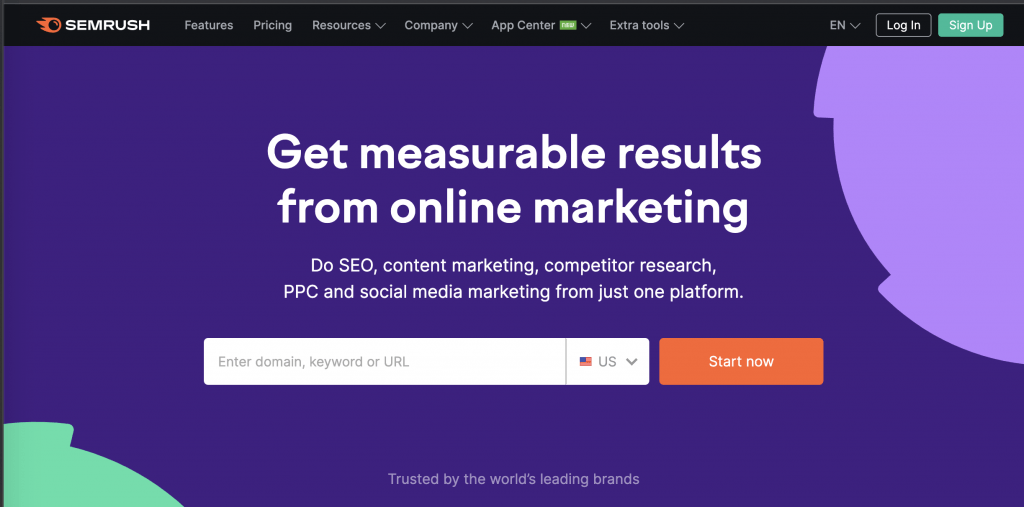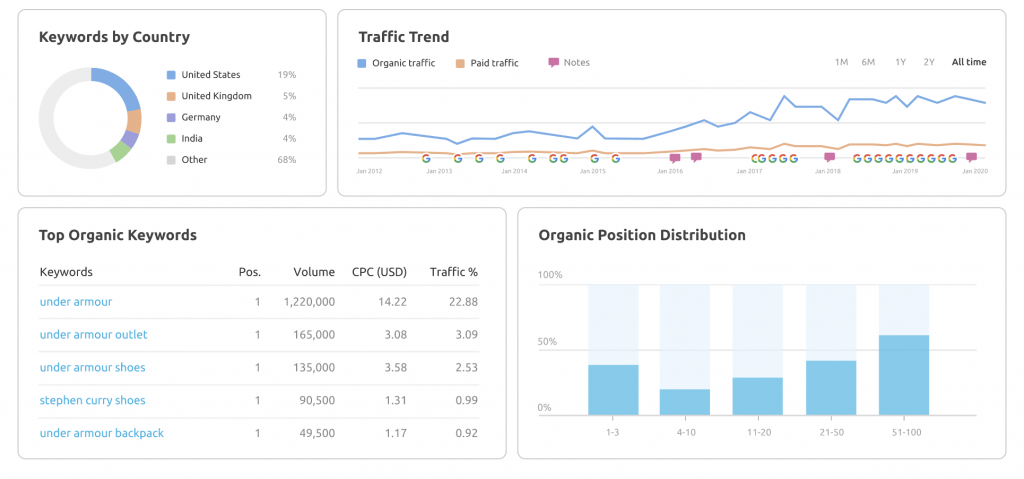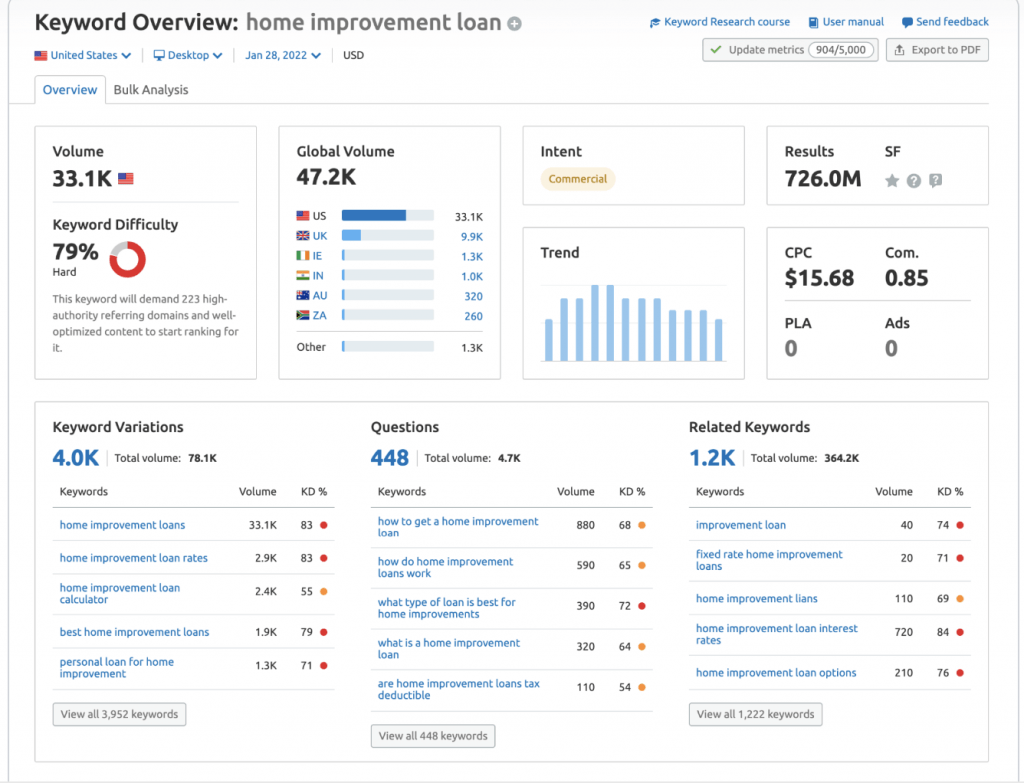Quick Links
Search engine optimization is a staple of digital marketing, with 61% of marketers citing their SEO efforts as their #1 inbound marketing priority.
It’s easy to see why, as SEO ROI can be as high as 12x your original marketing spend.
As such, implementing an SEO strategy is a great way to generate more search traffic for your business or eCommerce store.
Yet, SEO is a complex process that requires in-depth keyword research, content creation, technical audits, link-building, and lots of competitor research.
You also need to keep a close eye on key metrics like search rankings, click-through rates, and conversion rates.
It’s too much to tackle alone, which is why SEO tools like Moz, Ahrefs, and Semrush are so popular.
They’re all-in-one SEO tools that allow you to conduct and monitor your entire SEO strategy from a single location.
Today, we’re going to take a detailed look at Semrush to see how it stacks up with other tools on the market. Is it worth your time to sign up for a membership, or are you better off using one of the other tools on the market?
Read on for our Semrush review and to learn more about its essential tools, functionalities, unique features, and pricing plans. And if you’d like to go ahead and check it for yourself, here’s a special Semrush offer.
What is Semrush, and What Does it Do?
Semrush is a search engine marketing platform offered as software as a service (SaaS). While the company is heavily associated with SEO (and they have many tools for it), they are officially an SEM (search engine marketing) company – hence the name Semrush.
What’s the difference?
SEO is entirely focused on optimizing websites to rank higher in the organic search. In other words, SEO companies DO NOT also offer paid search campaigns or PPC (pay-per-click).
An SEM company aims to generate traffic from both organic and paid search and offers strategies for both.
As such, the Semrush platform has tools for traditional SEO as well as PPC. So if your company only uses paid ads, you can still benefit from Semrush. You’ll be able to track your click-through rate, cost-per-click (CPC), and other crucial PPC metrics.
Semrush first came about in 2008 as the brainchild of Oleg Shchegolev, their current CEO. Semrush has over 7 million users and is one of the most popular platforms marketers use to manage SEO and PPC campaigns.
You can use Semrush to:
- Discover relevant keywords in your niche that you can use to write blogs
- Conduct a backlink analysis on your website and competitor websites
- Monitor your rankings on the SERPs (search engine results pages)
- Conduct a site audit to discover and fix technical errors
These are just a few of the tools and analysis features of Semrush, as we’ve only touched the tip of the iceberg. Let’s begin with one of Semrush’s most essential features – the Domain Overview dashboard.
Domain Overview: Semrush’s Domain Analysis Tool
From the Semrush dashboard, navigate to Domain Analytics > Domain Overview to check out this report.
The tool is straightforward to use, as all you have to do is enter a domain into its search bar, and you’ll get to see a detailed breakdown of how it’s performing in the search results.
Metrics that you get to view:
- Domain authority score
- Organic search traffic volume
- Paid search traffic volume
- Total number of backlinks
- Organic keywords
- Traffic distribution by country
- SERP features
By clicking on any of the metrics in the quick overview dashboard, you’ll get to take a more in-depth look at them – as Semrush has competitive research reports prepared for each section.
For instance, if you click on the organic keywords section, you’ll get to analyze the domain’s top keywords. That includes position tracking, keyword intent, PPC keywords, and more. This detailed data will help you refine your keyword research process.
Thanks to this versatility, you can use the Domain Overview report to either get a quick glance at a competitor’s performance or take a more in-depth approach.
Important note: The organic and paid search traffic figures are estimates and aren’t always 100% accurate. You may notice a discrepancy between the organic traffic figures you see on Google Analytics and Semrush, so bear that in mind.
In particular, this tool is invaluable for two reasons; performing competitor analysis and auditing your site to measure your progress and see where you can make improvements.
Performing competitor analysis with the Domain Overview report
If you want to succeed with SEO, you need to note what your competitors are doing and how well they’re performing.
The Domain Overview dashboard makes this a quick and easy process.
Say that you’re working on building backlinks, and you identify a website that you think might make a good candidate. Well, you don’t want to go to the trouble of doing outreach and obtaining a backlink only to realize the domain has a poor authority score.
To avoid this, you can quickly enter their URL into the Domain Overview tool – where their domain authority score will be front and center.
Beyond that, you can use the report to gauge your top competitor’s strengths and weaknesses. If you’re attempting to rank for a specific keyword, you can check to see how competing websites rank for it first.
That will help you identify ideal target keywords for your website that won’t have much in the way of competition.
You can also analyze a growth report of a domain’s search engine performance over time. That will help you gauge how well your website or competitor’s websites are doing in the long-term scheme of things.
Competitive Positioning Map feature
The ‘Competitive Positioning Map’ is a unique tool that lets you visualize how well your site or a competing site is performing within a particular market.
If you’re in the health and wellness niche, entering your URL into the tool will let you see how your website stacks up with others. It visualizes the data by representing each website as a circle on a line chart.
Vertically, the line chart measures organic search traffic, and it measures organic keywords horizontally.
The sites that have the most traffic and rank for the most keywords are on the top-right of the chart – and their circles are also more prominent.
It’s a quick and unique way to visualize how your website fits into your niche as a whole.
Using the Domain Overview report as a site audit tool
The Domain Overview report can also provide valuable insights into your domain. In particular, you can identify areas that need improvement by glancing at the report.
For instance, if you’re putting a lot of effort into raising your domain authority, this report is a quick way to monitor your progress.
The same is true if you’ve been trying to rank higher for specific keywords or generate more organic traffic. The Domain Overview report will keep track of all your essential metrics in one location, which is very convenient.
If you’re curious where most of your traffic is coming from, the traffic distribution by country section is helpful.
It will let you know which countries are driving most of your traffic with a quick glance. That way, you can determine if you need to boost your marketing efforts in other countries or stick with what’s working in the countries generating the most traffic.
Another useful feature is the search intent breakdown under ‘Keywords by intent.‘
This will let you know why users primarily visit your website. For example, if you notice that you’re ranking for informational keywords more than others, it’s a sign that users flock to your website to learn things instead of making a purchase.
That can be either good or bad, depending on your business type. Regardless, this feature allows you to gain insights into your target audience and how they interact with your website.
How useful is the Domain Overview report?
Overall, the Domain Overview report on Semrush scores an A- from us. It’s a near-perfect tool that’s perfect for gaining valuable competitor insights as well as conducting an SEO audit on your domain.
Being able to quickly get a gist of how a competing domain performs on search engines is extremely useful, and most of the metrics in the report are backed up by hard data.
The layout of the report is intuitive and easy to digest. A noticeable perk is that Semrush now includes the domain authority score at the top of the report (it used to be buried elsewhere). That makes it a great tool to use when vetting domains for backlink opportunities.
It’s also nice that it works as both a quick glance tool and an in-depth one, which is why it’s one of Semrush’s most heavily used features.
The only noticeable downsides are the lack of accuracy in the organic and paid traffic analytics and the lack of an organic-to-PPC ‘traffic cost’ feature.
What’s that?
It’s where the tool lets you know how much it would cost to replicate a website’s organic traffic with paid ads. Other SEO tools on the market, such as Ahrefs, include this feature in their domain overview reports.
Semrush does indeed have this feature, but it’s buried under Organic Research. Including it front and center on the Domain Overview report would have been useful to marketers engaged in PPC campaigns.
Keyword Overview: Semrush’s Keyword Research Tool
As SEOs (search engine optimizers), we live and die by the quality of our keywords, so a robust keyword research tool is a must for any SEO platform.
Ideally, you want to discover the search volume and keyword difficulty for any given keyword to find out if it’s worth pursuing. Beyond that, it’s helpful if an SEO tool can provide keyword suggestions for future content.
Enter the Keyword Overview report, Semrush’s dashboard for everything keyword-related, including all the features listed above and more.
The primary features of this report include:
- The number of monthly searches for a particular keyword on Google
- The keyword difficulty score (KD)
- An accurate list of all the websites currently ranking for that keyword
- A list of alternative keyword suggestions
- The CPC for the keyword
- The keyword’s global search volume and breakdown by country
- Keyword variations to use
- Common questions containing your keyword
As you can see, the report contains a lot of detailed information about any keyword you enter into it.
Semrush’s keyword difficulty score
The keyword difficulty score is one of the most crucial metrics to look at for any keyword you’re considering using, and Semrush tends to do a great job in this regard.
It represents KD as a percentage out of 100, with higher scores, meaning it’s more difficult to rank for that keyword. Beyond that, Semrush also provides the number of backlinks you’ll need to acquire to stand a chance at outranking the competition.
That’s a useful feature that will help you gauge how realistic it will be to outrank competitors for any given keyword.
If the KD is above 50% and indicates that you’ll need 100s of backlinks to compete, it’s best to find another keyword.
Important note: A downside here is that Semrush doesn’t always provide the number of backlinks and instead lists general advice like, “you need better on-page SEO, link-building, and promotional efforts.” It would be better if they avoided general statements and instead provided specific information.
The Keyword Magic tool
If you want to rack up some valuable keyword suggestions, you need to use Semrush’s keyword magic tool.
Essentially, this is a keyword suggestion tool with a fancy name, but it more than gets the job done.
Whenever you enter a keyword into the tool, it will list a series of related keywords. There are also filters you can use on the results like:
- A specific keyword difficulty range (very easy, easy, possible, difficult, hard, very hard)
- Its monthly search volume
- The CPC for each keyword
These filters make it effortless to quickly find secondary keywords you can use alongside your primary one. You can also use this tool to find new primary keywords that may be stronger than the ones you already have.
For example, if you notice that a keyword suggestion has a higher search volume and lower KD than your primary one, it’s worth making it your new primary keyword.
This tool’s strength is its filters, as you can get incredibly specific with the results. As an example, the filters for KD are very diverse – giving you as much wiggle room as possible when selecting new keywords.
Another filter is the ability to exclude certain words from suggested keyword strings. For instance, you can tell Semrush not to include negative terms in your keywords.
Broad match, phrase match, and exact match filters
The keyword magic tool allows you to filter keyword suggestions based on how closely they match your entered phrase.
There are three filters you can use here:
- Broad match. This filter will display keywords that relate to the overall topic of your keyword. I.e., the tool will match the keyword’ massage service’ to ‘Swedish massage prices.’
- Phrase match. This filter includes long-tail keywords that contain your keyword in them. I.e., ‘massage service near me.’
- Exact match. This filter only displays keywords that have the exact same meaning as your keyword. I.e., ‘body rub service’ with ‘massage service.’
These filters grant you a significant amount of freedom when it comes to generating keyword suggestions, which is a definite plus. If coming up with keyword suggestions is a primary reason you want to use an SEO toolkit, Semrush will not disappoint.
Keyword Intent
Another unique Semrush feature is that it lists the intent beside each keyword suggestion in the keyword magic tool.
The keyword intent is represented by the letters I (informational), N (navigational), C (commercial), and T (transactional).
Here’s how the platform defines each one:
- Informational intent means the user is hunting for the answer to a question.
- Navigational intent means the user is trying to navigate to a particular page on your website.
- Commercial intent indicates the user is looking into brands or services to make a purchase eventually.
- Transactional intent means the user is ready to make a purchase or complete another type of action (newsletter sign-ups, etc.).
This is a valuable feature that you won’t find on competing platforms. With these filters, you can focus on one specific type of intent, such as transactional. That seriously comes in handy if you’re trying to boost your conversion rates.
Conversely, if your goal is to become a thought leader in your industry, you can customize the keyword magic tool to only display keywords with informational intent. That can help you spark ideas for helpful blogs, videos, and infographics that solve user pain points.
How useful are Semrush’s Keyword Overview report and toolset?
The Keyword Overview report is one of Semrush’s most vital marketing tools, and it scores an A from us.
Like the domain analysis dashboard, the layout is simple and easy to comprehend. Also, there are lots of differentiators here that set Semrush apart from the pack. It’s the only tool that allows you to filter for specific types of intent, which is extremely valuable.
The other filters, such as keyword difficulty range, are very versatile and customizable.
Yet, there’s only one reason why Semrush’s keyword toolset didn’t score an A+: all its data is for Google Search only.
While Google is undeniably the largest and most widely used search engine, they’re far from the only game in town.
Ahrefs leads the pack in this regard, as they provide data from Google, Bing, YouTube, and Amazon.
In today’s age, lots of smaller companies are opting for Bing SEO due to the lower competition. If you’re one of them, you’ll want to go with Ahrefs instead of Semrush.
The Semrush Content Marketing Suite
As long as you’re on the Guru plan or higher, you gain access to Semrush’s suite of content marketing tools.
There are tools for researching topics, writing SEO-friendly content, managing your content calendar, and more.
The SEO Writing Assistant is probably the most helpful feature for creating content.
What’s that?
It’s a tool that will evaluate your content and determine areas for improvement. Whenever you write a blog, script, or whitepaper, the SEO writing assistant will assess its strengths and weaknesses and provide a report.
Instead of copying and pasting content into the tool, it works as an add-on for WordPress, Google Docs, and MS Word.
While that may seem cumbersome at first glance, we actually think it’s a plus. With the tool working alongside you in real time, you can actively correct issues while you create the content, which is a timesaver.
Content audits and brand monitoring
Semrush’s content marketing tools also include audits, post-tracking, and brand monitoring.
The Content Audit tool will let you know whether the piece will resonate with your target audience or not. If it locates any areas for improvement, it will recommend you rewrite the content.
The Post Tracking tool will allow you to measure the success of each post. You’ll get to view its total number of shares on social media, its current search ranking, and the traffic it’s generating.
The Brand Monitoring tool lets you analyze your brand mentions across the internet. That includes any mentions you received on the web, forums, Twitter, and Instagram.
You can also create a content editorial calendar, create tasks for your team, and monitor their real-time progress.
In short, Semrush provides everything you need to manage your content marketing strategy in one place. Overall, its content marketing tools get an A- from us. They’re fantastic, but they would also be better if they were included in the Pro plan. As it stands, you can only access the content marketing toolkit if you have the Guru plan or Business plan.
The Position Tracking Tool
In the next part of our Semrush review, we’re looking at its position tracker. It’s the primary tool you will use to keep track of your rankings on the SERPs – which is critical to SEO.
As such, you’ll likely want to keep an eye on your rankings quite often.
Luckily, the position tracker in Semrush is easy to set up and intuitive to use. All you have to do is navigate to the Position Tracker section and then enter your domain and target keywords into the search console.
Once that’s done, you’ll be greeted with a detailed report on how your website ranks for those particular keywords.
It’s crucial to note that this is a tool that becomes more effective with time. The longer that you have it set up, the more detailed information it will have about your rankings.
You can set specific parameters here, such as filtering the results on a per-country basis.
This tool is also effective for gaining competitive intelligence – as you can easily enter competitor domains into the Position Tracker. That will let you know how well competitors rank for your target keywords, which can influence your decisions.
Last but not least, you can set up automated emails to trigger whenever something significant happens with your rankings. That’s a great feature, as you’ll instantly know if you rose or fell in the rankings.
How good is Semrush’s position tracker?
Semrush’s position tracker is one of its best SEO tools due to how reliable the data is and the option to automate email notifications.
In fact, if you cross-check the data from the position tracker with your data from Google Analytics and Google Search Console, you’ll find it’s incredibly accurate.
This tool gets an A+ from us for that reason. The only downside is the default view shows changes in rankings from the top 100 results.
If you’ve ever used a search engine, you know that page 2 is just as good as page 50. We think it would be better if the default view only included position rankings from the top 10 or 20.
Semrush and Backlinks: Backlink Analysis and Backlink Audit
Now let’s move on to Semrush’s tools for backlinks. Link-building is pivotal to a successful SEO strategy, so helpful tools in this area are a must.
Semrush has quite a few reports and tools you can use to monitor backlinks, find backlink opportunities, and more.
In particular, it uses two tools for backlinks; the backlink analysis tool and the backlink audit tool. Let’s take a detailed look at each to see how they perform.
The Backlink Analysis Tool
This tool operates like any other backlink checker, albeit with a few unique features. You enter a domain name, and you’ll get to see a complete list of all the backlinks pointing to it.
There are a number of uses for this tool, including viewing your backlink profile and that of competitors.
There’s also:
- The anchor text for each backlink
- The top-level domain distribution (how many .edu and .gov links point to it)
- The IP address for each backlink
This valuable information will help you determine which backlinks are worth pursuing. You can also use this tool to uncover insights for content creation.
For example, if you want to summarize a complicated study, you can enter the domain into the backlink analysis tool. From there, you’ll be able to see other articles that link back to the study – and they’ll likely have a simplified explanation of the results.
The backlink analysis tool displays the following metrics:
- Backlink types (text, image, form, frame)
- Link attributes (follow, nofollow, sponsored, UGC)
- Total number of backlinks
- Referring domains
- Referring IPs
Like the Keyword Overview and Domain Overview dashboards, you can use plenty of filters on backlink results. For example, you can choose only to view ‘follow’ backlinks from a particular domain.
Along with Moz, Semrush has the largest database of links out of all the other SEO tools on the market, with 43 trillion links in its database. Generally, the more extensive the database, the more accurate the data. For the most part, Semrush’s backlink data is highly accurate.
The Backlink Audit Tool
The other tool Semrush has for backlinks is its backlink audit tool. This tool is primarily used to rid your site of toxic links and to improve your ‘site’s health.’
Not all backlinks are equal, as links coming from websites with poor domain authority will hurt instead of help.
During a backlink audit, Semrush will separate your high-quality backlinks from links that it views as spammy.
If you agree with the tools’ judgment on a backlink, you can upload it to Google with a ‘disavow’ file to get rid of it.
This feature is helpful for ensuring that you have a healthy backlink profile free of broken links and spam. The tool displays your backlink profile as a bar with three different colors: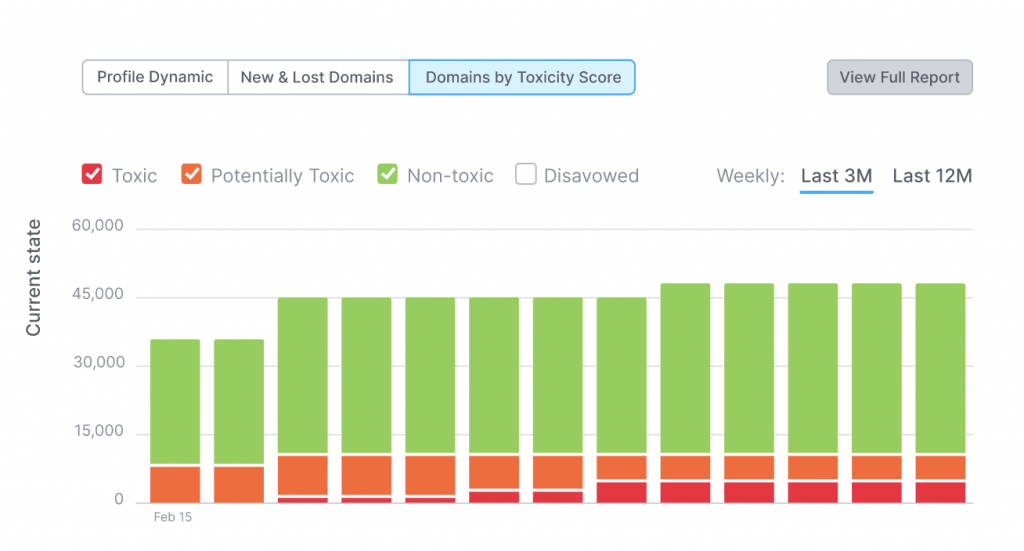
- The green section represents all your high-quality links that are non-toxic.
- The orange section represents potentially toxic links (it’s essential to review these manually).
- The red section represents links that Semrush views as 100% toxic or spammy.
While this tool can be useful, some SEO experts view link disavowal as a waste of time. To ensure you don’t end up deleting high-quality links, you should manually check each link Semrush flags as spam.
How good are Semrush’s backlink tools?
Overall, Semrush’s backlink tools score a B+ from us. The backlink analysis tool is undoubtedly useful, but the validity of its backlink audit tool is up for debate.
For example, Google Trends analyst John Meuller swears against disavowing toxic links and claims link disavowal rarely leads to positive effects on search rankings.
Yet, some backlinks are indeed toxic and can hurt your SEO, so it’s not always a bad idea to disavow some of them. You just want to ensure that you don’t get rid of any links that are actually bolstering your backlink profile.
Semrush’s Link Building Tool 
Acquiring backlinks is a core part of any SEO strategy, and Semrush has a great tool to help you out with that.
In fact, Semrush’s link-building tool can become your secret weapon for acquiring links.
That’s because it lists many ‘prospect websites’ that it feels are great backlink/guest posting opportunities.
That will save you A TON of time doing backlink research, which can typically take hours. Instead, Semrush compiles thousands of domains from your niche that you can use for backlinks.
The link-building tool doesn’t stop there, either. You can connect your inbox to Semrush to handle email outreach straight from the platform.
Beyond that, you can keep tabs on all your outreach emails within the tool. That makes doing outreach for backlinks a breeze, and it’s effortless to stay organized.
You can even save certain emails as templates for later outreach. It’s yet another time-saving feature that simplifies the link-building process.
This is where Semrush truly shines, as none of its competitors offer similar features. For most, the link-building tool is the #1 deciding factor for why they chose Semrush over Ahrefs, Majestic, or Moz.
Broken link building through Semrush
If you’re a beginner at link building, you may not know about broken link building. It’s where you use a tool like Semrush to identify broken links on sites related to your niche.
Broken links are bad for SEO, so the site owner likely does not want a broken link hanging around.
If you can identify a broken link and offer related replacement content (i.e., a blog from your website), you can pick up a backlink. The webmaster is likely to agree as it eliminates a broken link for them, and it’s a win for you because you acquire a new backlink.
Can you do broken link building through Semrush?
The answer is yes, but it’s not as simplified as it could be, which is unfortunate. As it stands, you have to run a backlink analysis, click the ‘broken pages’ option, and export the file as a CSV or Excel file. After that, you can filter the file to display 404 errors.
So while it’s still possible, it’s buried behind several menus, which makes the process rather time-consuming. Other platforms, such as Ahrefs, simply have a ‘broken link’ option where you can instantly view all the broken links for a given domain.
On the plus side, once you have your broken links file, you can re-import it to Semrush so you can conduct all your email outreach within the platform.
How good is Semrush’s Link Building Tool?
Overall, we have to give Semrush’s link-building toolset an A+. Many users cite its link-building tool as THE reason they went with Semrush over the competitors, and it’s easy to see why.
Semrush makes the entire link-building process quicker, easier, and more effective.
It streamlines everything from identifying backlink opportunities to doing email outreach and monitoring your success rate.
Being able to conduct email outreach within the platform is a huge deal, and it’s a feature none of Semrush’s competitors have.
The only downside here is that broken link building is a bit complicated. In the future, Semrush would benefit from adopting Ahref’s style of handling broken link building. Still, it’s undeniable that Semrush leads the pack in terms of link-building capabilities, which is why this tool gets a flawless rating.
The Semrush Site Audit Tool
Now it’s time to take a look at how Semrush can help you with your technical SEO. The Site Audit tool will crawl your website for any technical errors, such as:
- Broken links
- Duplicate content
- Crawl errors
- SSL errors
- Missing headers, alt tags, and meta descriptions
- Google’s Core Web Vitals
These are all issues that will negatively affect your SEO, so it’s handy to see them all listed in one report.
Once identified, you can export the tasks to Trello or to Semrush’s built-in CRM tool. There, you can correct any issues that the site audit tool finds.
Then there’s the on-page SEO checker that will help you further improve your content. It provides tips to enhance each piece of content that it lists in order of priority for your convenience.
Its suggestions include which keywords to use, how to rank for featured snippets, strategies for internal linking, and more.
The site audit tool is invaluable for conducting technical SEO audits, and the on-page SEO checker will help you optimize your content. Overall, we give its site audit tool an A.
An Overview of the Semrush Pricing Plans 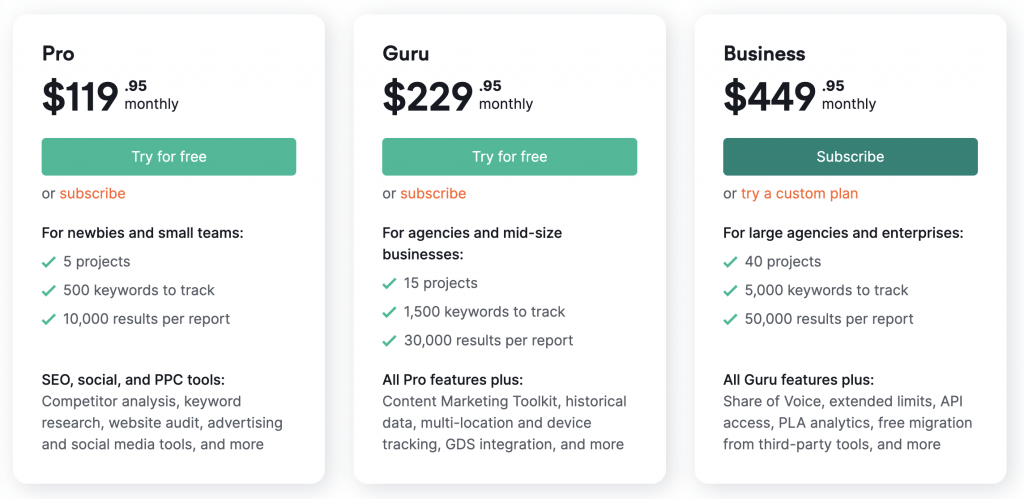
This wouldn’t be a proper Semrush review if we didn’t discuss its pricing options. Semrush offers three pricing plans to its users:
- Pro Plan: $199.95 per month. Includes 5 projects, 500 keywords, and 10,000 results per report.
- Guru Plan: $229.95 per month. Includes 15 projects, 1,500 keywords, and 30,000 results per report. Also provides access to historical data, the content marketing toolkit, and more.
- Business Plan: $449.95 per month. Includes 40 projects, 5,000 keywords, and 50,000 results per report. It also has Share of Voice, extended limits, the content marketing toolkit, and more.
Each plan includes a free trial and the option to form a ‘custom’ plan.
Semrush Review: Delivering the Verdict
Overall, Semrush gets a solid A. It’s definitely one of the best SEO tools on the market, with its standout features being its link-building tool and keyword tools. It’s an excellent option for small businesses and enterprises alike.
That’s our Semrush review for 2023. What did you think? Let us know in the comments below, and feel free to use this link to try Semrush and see for yourself.
Do you not have time to manage your SEO strategy? If so, don’t wait to get in touch with us at HOTH X to take advantage of our high-end managed SEO services.







